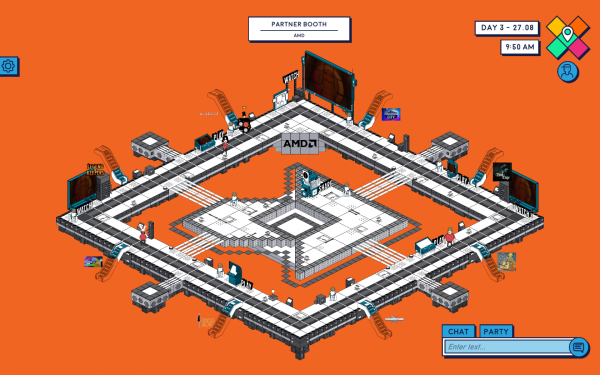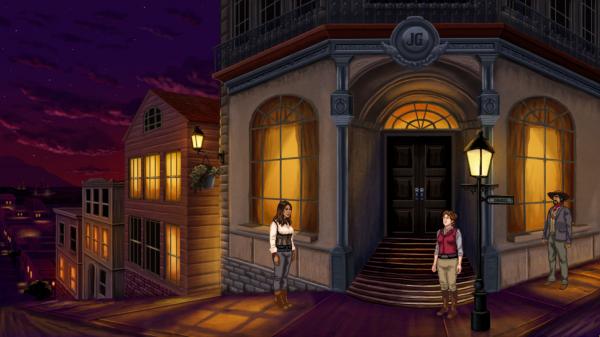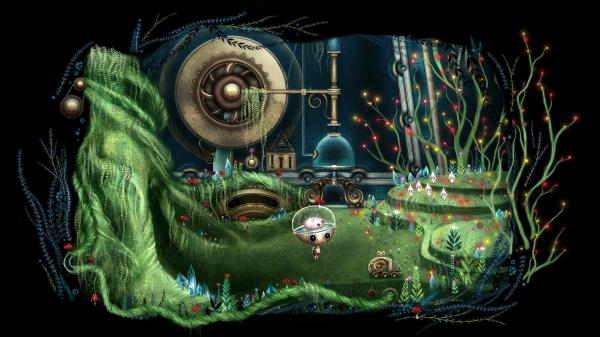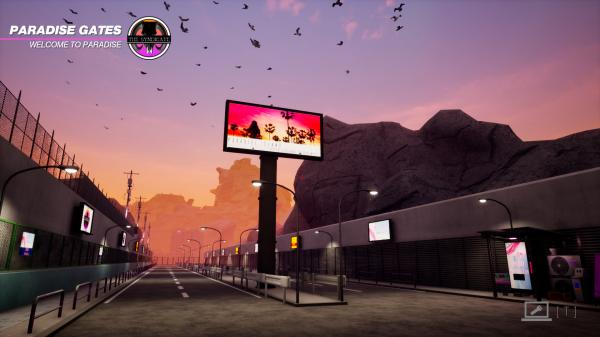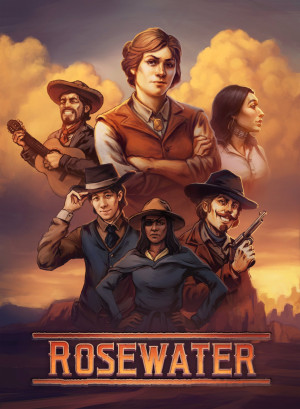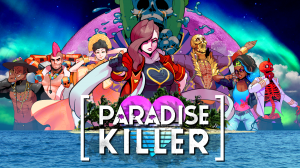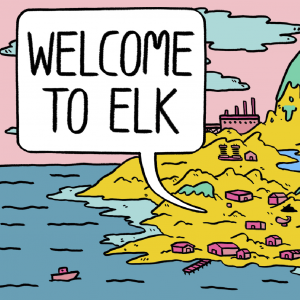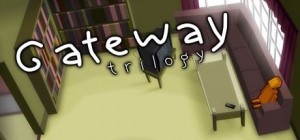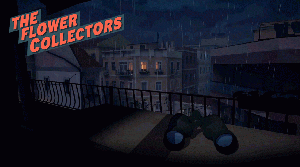Gamescom 2020 round-up: Part 2
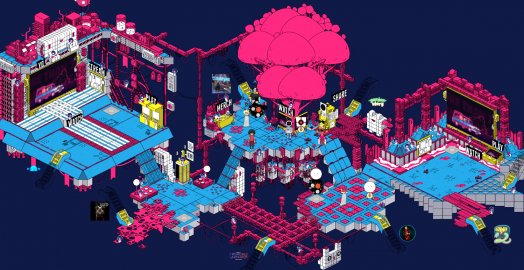
My memories of last year's gamescom, the first (but hopefully not the last) time I got to attend the event at the humongous Koelnmesse in Cologne, are filled with me frantically searching for booths, eating lots of takeaway German sausage, and, of course, meeting lots of friendly adventure game developers eager to show me their exciting new projects. Whilst this brave new world of 2020 means I no longer had any frankfurters to chow down on as I went about my adventure gaming business, thanks to this year's Indie Games Booth I was still able to chat with lots of different developers about their games, albeit only virtually through an online avatar.
This isometric browser-based meeting place – kind of like a more brightly coloured and game-focused Habbo Hotel – worked for the most part, with each developer able to set up their own personalised area, complete with interactive screens with links to their Steam page, game trailers and Discord channels. There were some teething problems with the chat function, and the site did crash once or twice for me. But as someone with short legs I was pretty grateful to be able to type in the title of a game showcasing at the event and be whisked there straight away, instead of facing the usual gamescom hoards.
Here's hoping that next year we won't need such a model to talk about great games again, but if we do, gamescom 2020 has proved that there is still a viable way of interacting with developers virtually. There was certainly no shortage of great-looking games to check out, as my fellow Adventure Gamers colleagues and I still managed to fit in plenty of demos to test out even though we couldn't be there in person, so following on the first half of our two-day coverage, read on to learn about more promising adventures that caught our eye.
Rosewater
Like a grizzled cowboy with a sudden surprise second wind, Rosewater punches you round the chops with a whole host of choices. In this entertaining point-and-click pixel art jaunt through the Wild West set in an alternate 19th century, you can pick your friends, your enemies, and even your puzzle solutions. Playing as pugilist-turned-freelance writer Harley Leger, the demo saw me arrive in the so-Western-it-hurts town of Rosewater looking to speak to the editor of the local paper, a seemingly simple task that eventually leads to being assigned to help in its search for a missing scientist's fortune, while encountering a whole heap of trouble along the way.
To find that fortune you'll end up making five travel companions who'll form part of your posse, a few of which I got to meet (or deeply annoy) in the demo. Developer Francisco Gonzalez of Grundislav Games tells me that later in the game we'll be given companion-specific quests too, two for each companion but only one you can access, depending on how well you're getting on with them. Whilst the demo wasn't voiced, Francisco says the plan is that all fifty-plus characters will be by the time the game is finished. And there’s plenty of interaction to be had with the town's eccentrics; from the local pickpocket to the man you “meet” after he comes flying out of an upstairs window, a variety of colourful tropes of the Wild West are all here in beautifully rotoscoped animation.
Whilst Francisco says there will be some slight crossover with his previous adventure, Lamplight City, including the return of one or two unmentioned characters from that game, one thing that won't be returning will be the lack of inventory. Instead, this time players will see a streamlined take on the system. Basically this means that objects that can be used with an inventory item will be highlighted, whilst ones that can't, like signs, will not. This is to try to stop the “use everything on everything” approach that desperate adventure game players resort to when they don't know where to turn next, and it seemed to work pretty well in the demo.
That's not to say there won't still be puzzles, though, all of which will apparently have a few solutions. I was told that even the demo has plenty of ways to solve the main challenge, including an “extra extra jerk” path, which, my being such a nice person, obviously never presented itself. But as well as giving you lots of extra choice, Rosewater will, in a sense, also take some of that away in the second act of the game. There, as you make your way to your treasure goal with your ragtag gang of misfits, players will be presented with “random vignettes,” says Francisco. These will be chance events and quests you can participate in, so you won't encounter every one of them in one playthrough. The aim apparently is to make it feel like a road trip with your mates (though I'd suggest abandoning your trip if some of these people were your pals in real life).
However, rest assured that whilst your changing relationships and quests will add a different layer to big story moments, if you're only planning to play through the game once, you'll still experience the full story, just not see everything a replay would have to offer. Judging by the sheer number of people to meet and things to do in Rosewater, however, you'd have to be a few pints short of a jug of moonshine not to want to give it at least one extra go when it comes out at some point in 2021. Yeehaw!
Growbot
The charming 2D point-and-click adventure Growbot, with beautiful artwork reminiscent of an Amanita Design classic, is the first from developer Lisa Evans of Wabisabi Games. In a quick catch-up during gamescom (over Zoom, of course), she told me how coming from an arts background she had always been interested in getting to grips with making her own game, but it wasn't until she found the Adventure Creator toolkit that she was able to slowly but surely make her dreams reality.
Growbot's themes follow some of Lisa's interests outside of gaming, mainly the future of tech and transhumanism, as you play Nara, the titular robot who lives aboard a biopunk space station and is training to be a captain. The demo starts with you on your first day of the job, trying to find your commander after a dark crystalline force attacks the ship. The inventory is split into “keepables” or “consumables” on either side of the screen which you can examine with a right-click of the mouse. Keepables seem to be pieces of literature and lore to help you understand the world, like a book I picked up about the history of the Growbots. Whereas consumables are items you can use to help you progress through the story, like keys.
To help you distinguish which things you can interact with, the cursor flashes red over applicable items in the room when passing over them, from flowering pictures of asteroids to little changing kaleidoscopes. Searching the room is a soothing experience, in no small part down to musician Jessica Fichot's quiet, reflective piano score, but also due to the tiny pitter-patter of Nara's feet as she moves around. It's a meditative few minutes compared to the normal gamescom hustle and bustle!
Once I found the captain, it was time for the main puzzle. Lisa says she doesn't want puzzles in Growbot to be too taxing, and to this end my task was a fairly simple case of putting pieces of the rather broken captain back together by slotting mechanical parts into the right grooves. Later in the game there will also be puzzles involving collecting the “sounds” of flowers and combining them to create powerful shields, which will no doubt help protect our little Nara from the evil crystals. The demo was over all too soon once I’d powered the captain back up, but with its stylish world, cute characters and intriguing backstory, I'll be sure to return to Lisa's creations again when Growbot bursts into life at some point next year.
Ghost on the Shore
The last time I spoke to developer like Charlie's Dagmar Blommaert about her game Ghost on the Shore was at last year's gamescom. And just as a lot has changed in the world since that meeting, so too have several elements of her first-person supernatural adventure about remembering and letting go. One thing that remains the same is the story, which sees you playing as Riley, a reluctant protagonist who finds herself washed up on the shore of a deserted island after a sailing trip gone wrong. Even more perturbing, she suddenly has the voice of Josh, a rather persistent ghost who can't remember anything about his previous life, stuck in her head. Both decide (and desperately hope) that they can become free of each other again if Riley is able to help Josh remember who he once was, so the pair (or Riley and . . . her thoughts) head off to investigate the island in hope of uncovering lost memories.
Dagmar tells me there are now three islands to explore in the finished game, though the demo saw me mainly exploring part of one and interacting with my newfound ghost visitor. It's also a lot easier now to make dialogue choices when presented with them using a dialogue wheel, which lets you flick between different options. Both Riley and Josh are voiced, their tones ranging from playful to curious to fed up as they explore their forced relationship together. The answers you give to Josh's questions can't be taken back and will define your and Josh's relationship – and potentially, Dagmar suggests, depending on where they get to with development – also affect how easy some puzzles are to complete.
Most of the demo involved investigating the ruins of old shacks and houses around the first striking 3D island. You're not only uncovering little pieces of Josh's life from his anecdotes, but through environmental storytelling you'll also learn more about the lives of the people who left the island behind long ago. Dagmar suggested that the island itself will become a character of sorts, too, as Riley begins to see visions as if the world around her is talking to her. Which perhaps should come as no surprise, as the idea for the game came mostly to Dagmar in a dream.
If you too want to commune with the dead in the ultimate island getaway, you’ll have that chance when Ghost on the Shore is released sometime next year.
Aethernaut
You'll get hints of Portal and Discolored in Aethernaut, a first-person 3D puzzle game which sends players on a mission to venture inside “The Construct,” a steampunk laboratory-like area seemingly once teeming with researchers but now eerily empty. I was guided through the demo by the voice of Doctor Louis Cornell, who explained that I’d volunteered to help gather vials of a substance called aether that has flooded the rooms, reset the Construct's experiments, and hopefully help the facility return back to normal after its abandonment. But whilst the doctor was mostly helpful during the demo, the game's Steam page description suggests that, as is usually the case with unseen overseers in video games, everything may not be as it seems.
As for the puzzles themselves, the demo showed off a variety of pressure pads and switches, which you'll need to do some clever things with glowing cubes and light projectors to get past. It might involve simply moving a projector closer so that its coloured beam hits a light switch to activate the door to the next puzzle room, or you might need to first find the matching glowing cube of light to the projector, using a bit of simple platforming by jumping up onto a ledge. Sometimes picking up the puzzle elements needed a couple of attempts at clicking before the game registered what it was I wanted to take, but there’s still time to smooth such things out for the game proper.
While I didn’t see them first-hand, the full game promises portal and time travel puzzles alongside the light trickery, so there should be plenty to sink our teeth into when Aethernaut comes out for Windows, Mac and Linux, though there’s no word yet on when that will be.
Mindcop
Got room for one more noir detective game on your wishlist? You will do once you discover this inventive nonlinear 2D side-scroller. Animated in shades of black, grey and white, the game sees you play the titular Mindcop, who, along with your assistant (or as she corrects you, partner) Linda, has travelled to a town in the middle of nowhere to solve a murder. Once you arrive, you soon find out that apart from moving, everything in Mindcop, from questioning a suspect to inspecting a room for clues, costs time. The amount of simulated time you have left is shown in the bottom left-hand corner, and the game lets you know how much each action will cost you – say, four seconds to investigate a desk, fifteen to search a body for clues – before you select it. Run out of time and your day will end, which no doubt will make for some careful decision-making as you try to make every day of your investigation count.
And what of Mindcop's special abilities? It's a title well-earned, as this ever-so-slightly-grumpy police investigator is able to surf people's brains like a kind of grizzled Raz from Psychonauts to find information they might be hiding. This is played out as a Tetris-style minigame, with the player having to rotate a cube-like brain with different coloured sides. The aim is to slow down a ticking time counter enough that Mindcop can surf all the way to the finish line and enter the unsuspecting person's brain. This is done by matching coloured “mind bullets” that shoot into different sides of the cube with the same colour on the cube. There are plenty of extra layers to the minigame – don't match the bullets with their coloured cube side and they become blocks that can only be destroyed by making a chain of three or more – which make it much more than just a fun gimmick to the main story.
Based on the demo I played, Mindcop will offer plenty of choice, from dialogue options, to being able to arrest anyone you please whenever you want, to simply deciding how to spend your time. While waiting for the game to be completed sometime next year, one option that shouldn't be negotiable is trying out the demo for yourself, which is available now on itch.io for Windows PC.
Paradise Killer
by Ariel Nakandakare
Paradise is dead. And it is up to you to find the culprit.
This first-person open-world murder mystery puts you in the shoes of “investigation freak” Lady Love Dies as she gets dragged out of her exile to investigate a heinous crime in a land of immortal beings. Exploring the synthetic island of Paradise to discover its secrets for an hour or so was a highly enjoyable experience thanks to its beautiful locations and colorful characters, though the amount of information the demo requires you to process right off the bat can be overwhelming.
While you can play Paradise Killer with a mouse and keyboard, the controls are far more suited to a gamepad, since moving through the 3D environments isn’t limited to walking and running, but also jumping, landing, clutching, dashing through the air, and even using a flashlight when the day/night cycle hits nighttime. Travelling across the island is quite surreal, since the whole place is a mixture of modern urban architecture, tropical landscapes and esoteric monuments of alien gods, all delivered in a colorful ’80s synthwave aesthetic.
The anime-inspired characters are just as distinctive. Everyone oozes style and personality, from their designs to their poses but especially their cool-sounding names such as Grand Marshall Akiko 14, The Witness of the End, and DOCTOR DOOM JAZZ. I end up playing the demo several times because of how interesting everything looks, and how much fun it is to talk to the suspects and explore every location, doing things like testing what the different kinds of terminals do or collecting blood crystals (a type of currency) scattered across the map to see what I could buy with them.
As for the investigation itself, it was possible to get a good look at the basic tools used to pursue the game’s main goal: building a solid case that can prove who killed Paradise and bring them to justice. Of course, even if it’s possible to form a theory, it is almost impossible to build a solid hypothesis in the span of just an hour, since traveling around the island to gather the info can take quite a bit of time. Fortunately, most of the places related to the case can be tracked through a device that tells you what direction you should go and how far away it is.
All the information (profiles, evidence, testimonies, etc.) about the case is gradually stored in a very organized database that even includes a timeline of events, which is great because there is a LOT of info to process. The main negative aspect of the demo is related to this, as the lore is presented through mostly contextual clues over the course of the investigation, making it feel like a detective spin-off of a well-established fantasy universe of which I had no prior knowledge. I was still able to enjoy both aspects of the story, but constantly having to make sense out of a lot of details without being properly introduced to what they are referencing did make the plot a bit harder to follow.
Overall, the demo did a great job showing the game’s mechanics and its vibrant world filled with crazy characters and plenty of mysteries to unveil. To find out how the full investigation turns out, there’s no need to wait, as Paradise Killer is available now on Steam .
Welcome to Elk
by Ariel Nakandakare
If there is one thing the demo for Welcome to Elk excels at most, it is leaving an impression on those who play it. It’s a “biographical adventure” whose main purpose is getting to know the inhabitants of a unique island, each of them with their own story to tell based on real events. This colorfully drawn, cartoony third-person game has a lot of creative ways to engross you in its anecdotes. You can share a beer with your neighbors or dance with someone you just met, though not every tale you’ll hear is a happy one.
As Frigg, the new girl in town, I got to explore my new home in a short ten-minute run. Elk is a place of foul weather, abundant nature, and a small community doing their best to live their everyday lives. The most remarkable thing about the experience here is how humane and real every interaction feels, with the atmosphere constantly shifting between fun and sweet to tense and uncomfortable. For example, when you go to the local bar to party with the townsfolk, everything goes great until the festive mood turns sour thanks to an angry drunkard trying to harass you in front of everyone. These moments are accompanied by a great country soundtrack that perfectly blends with the background sounds.
There were no puzzles in the demo, but lots of creative ways to make the narrative feel more dynamic, and to make you feel a participant in the story, not only a mere observer. The gameplay has been reduced to a minimum (the directional keys to move and a single action button), which the game makes the most out of, having things like a dancing minigame or a particularly fun sequence where you try to get back home after getting completely drunk.
Since the game tries to create an immersive atmosphere for each of its stories, keeping the user interface to a minimum is understandable. However, for those who don’t use a gamepad, it would be nice to at least have some way to know how to access the game’s main menu without having to randomly push keys until it pops up. At least, unlike the First Stories demo that was released before this one, there was a solid introduction to both the main plot and gameplay, even if the mechanics used here proved to be less creative than the ones shown previously.
Welcome to Elk is eager to begin receiving new visitors sometime on September 17th, and the demo suggests there are plenty of surreal secrets and emotional situations awaiting us there. Just be sure to pack some tissues with your boots as you get ready for the adventure.
A Space for the Unbound
by Evan Dickens
Most who consider themselves adventure fans likely profess a deep sense of fond nostalgia for the 1990s, so it’s never a surprise when an adventure game appeals to that nostalgia by setting itself in the era we often refer to as the Golden Age. Far less expected is that A Space for the Unbound, an upcoming side-scrolling adventure from Mojiken Studio, adds a unique aspect to the familiarity of the 1990s: the developer’s homeland of rural Indonesia. The demo for this “slice of life” adventure, the story of a relationship between two high school friends and their supernatural bond, previews a game with an interesting magical element and a whole lot of sweetness.
The prologue tells the story of Atma and Raya, close friends who are verbally collaborating on a make-believe mystical story featuring the South Star Princess and her cat. Raya has forgotten the final chapter of the story; as happens, it has become lost in the depths of her heart, and the only way to recover it is for Atma to use a magic red book and “space dive” – the game’s term for a physical exploration of someone’s inner feelings, which visually resembles a journey into outer space.
This chapter finds Atma traversing numerous areas of his home city, interacting with plenty of townspeople, street vendors, traffic directors, etc. The pixel art, a direct throwback to the era it portrays, looks even better while moving. The multi-scaled backgrounds give a depth to the 2D environments that is very appealing, and the screen is constantly filled with animation, from moving clouds to other characters walking to and fro. The game is fully controlled with three keys – A and D for left-right movement (with a double-press to run), and space bar to interact. Standing in front of an object that can be interacted with brings up an icon, and a press of the space bar brings a menu allowing you to select an action or an inventory item to use.
In playing through the prologue, I was overwhelmed with the downright cuteness of everything, from the “aw geez” G-rated dialogue, to the constant bright imagery of flowers and sunlight, to the genuine affection of friendship that is present between the characters – and of course, the presence of an abundance of cats, both in the fictional story created by our heroes and as their own real-world companions (certainly, in this writer’s opinion, nature’s cutest animal). The dialogue is both pleasant and plentiful; it’s clear there is going to be a lot of talking throughout the journey, though there is no voice acting, at least so far.
In learning more about this game, I happened to land on Mojiken Studio’s Twitter page, and couldn’t help but make note of the profile text: “We provide happiness to our family member, to inspire people, and build a better world to live in.” It is an exceptionally positive and agreeable mission statement that has never felt more urgent than it does in these current times we live in, and it is perfectly in line with the tone of this game. The game’s promotional materials reference story elements about anxiety and depression and threatening paranormal elements, but true to the positive spirit, the focus is on overcoming those rather than succumbing to them. While A Space for the Unbound likely won’t scratch the dark-content itch for those who like their game worlds bleak and edgy, it looks to be an incredibly pleasant game with a unique concept, a distinct visual appeal, and a whole lot of adorable felines when it releases “soon” on Windows PC.


